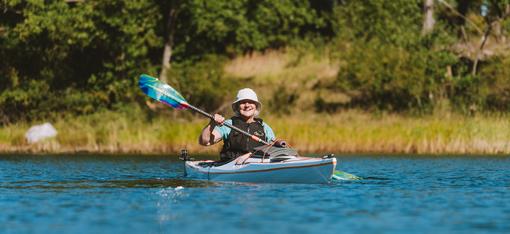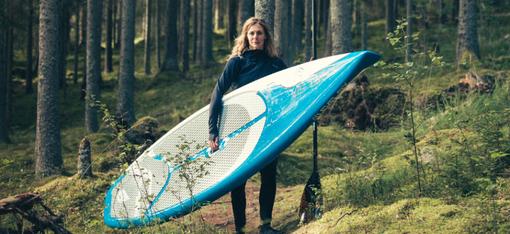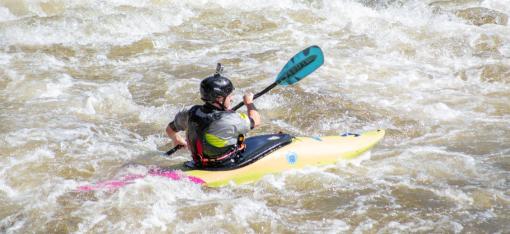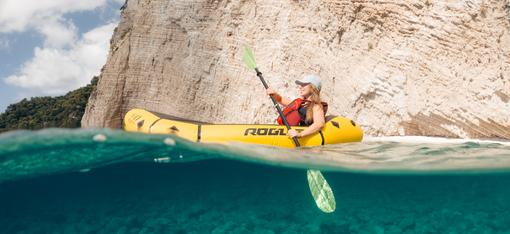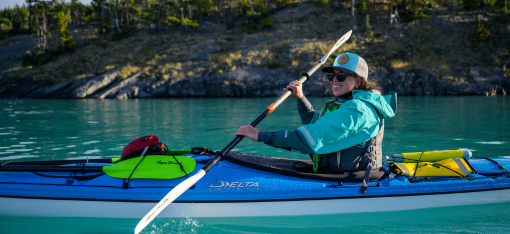Gear and Best Practices for Paddling Photography and Video
8-minute read
Seth West is a professional filmmaker and photographer who works with outdoor brands, primarily in the paddlesports industry (like Aqua Bound). If you love to produce your own photos and videos around your paddling adventures—or want to start—this is for you.

Seth West, kayaker and pro media producer
Seth took some time to offer his expert opinion on camera and video gear, as well as some best practices he’s learned in his years of both hobby and professional shooting and editing.
Here’s our interview with Seth West:
AQUA BOUND: What photo and video gear do you recommend for those just getting started?
SETH: I get asked this question all of the time. The real answer is that the best camera gear is whatever is accessible to you.
The odds are that if you're just getting started, it doesn't make sense to get the actual "best" gear for the job. It does make sense to get something you'll actually use and that won't stress you out if you take it on the water.
I will say on this note that it's great to try and fiddle with as many different manufacturer's cameras as you can before purchasing.
The first DSLR I ever bought was a Canon t3i in my early 20s. The layout of the user interface was super confusing to me, so I never really got into it. There was a massive hiatus between buying that Canon that I barely used and many years later starting to make YouTube videos with a kayak shop-provided Nikon D3200 that clicked way better with my brain and therefore motivated me to use it.
A few years later I bought a Sony a6400. That user interface worked really well for me, and I've been using Sony ever since.
Beyond finding a brand with a camera design that feels intuitive to you, it's also important to ask yourself how far you want to take it. You'll immediately find yourself choosing between sensor sizes—likely just APS-C, Micro 4/3, and full frame if you're getting started.
If you're just wanting to take a few snaps for fun here and there, APS-C or Micro 4/3 can be a great way to get started on a small budget. If you think you're going to get really into it, I'd recommend jumping straight to full-frame. I lost a lot of money in the transition from APS-c to full frame, and in hindsight, I always wish I'd gone straight to a used Sony A7iii instead of buying a new A6400.
Regardless of sensor or brand, I think it's important to get a weather-sealed camera if you're going to use it for kayaking. You will inevitably have some splashes here and there, and it's nice to have the peace of mind that your camera can at least handle a bit of that.
AQUA BOUND: What do you have to think about in a paddling environment that you don't have to think about on dry land?
SETH: Most obviously, water and electronics don't get along...at all. The weather-sealed element that I mentioned before is big, but even that may not save your camera if it's fully submerged.
I feel like I'm the ultimate guinea pig for just how waterproof my cameras are. I’ve stood literally inside of waterfalls with them and still not had one fail on me yet.
I also do not recommend doing any of the stuff that I do with my cameras, because at this point I'm really just in a game of chicken with the IPX ratings—at some point, it's going to be a losing battle for me.
Regardless, a good dry bag is key. Watershed and Level Six both make great stuff for photographers.
AQUA BOUND: Tips from shooting from the water vs. shooting from land?
SETH: Counter to what I just said in regards to cameras and water being enemies, I'm a big fan of shooting in a style I like to call "wet."
You'll hear people talk about shooting "dirty" which refers to having obstructions in the foreground to give a sense of environment and depth. I like to use water in a similar way. Shooting with the camera just above water level is a great way to do this.

"Shooting wet" and low to water
I also often will leave droplets of water on my lens to give a real sense of immersion in whitewater environments. I constantly play with new things to try and portray the feeling of kayaking and surroundings through the shutter.

Shooting even more wet—low to the water with droplets on the lens
AQUA BOUND: What gear did you "graduate" to that you currently use (if that's how you progressed)?
SETH: I’m in my fourth year as a full-time freelancer working in the outdoor industry at this point, and I was dabbling for quite some time before that. At this point, I've amassed a ton of camera gear that would be nauseating to list (and read), but I can dial it down to a few key bits.
For video, I use a Sony A7SIII. I’ve been running this for the past three years and I've thought about upgrading. But every time I consider this I watch my footage and compare it to footage from the potential upgrades and it just doesn't feel worth it. The A7SIII is an insane value in my opinion, and I'll likely run this camera until I finally lose my game of waterfall chicken with it.
For stills and hybrid shooting, I use an A7IV. Again, I consider upgrading sometimes but this camera is also a great value and a real workhorse. I do, however, always have a window open on my browser to check the used Sony A1 market.
Another key element in my current kit is a waterproof housing. I'm running a Seafrogs salted line with a glass dome to shoot underwater and I absolutely love it. This was the inevitable peak of my "wet" shooting experiments, and it's always a blast to use.
AQUA BOUND: What are your favorite storage apps or tools?
SETH: I’ve had to dabble with so many of these over the years. I have a pile of external SSDs that I keep all my stuff stored on for archival purposes. Outside of that, most brands I work with have their own library that I upload to.
Dropbox, Google Drive and WeTransfer have been the go-to for years, but recently a lot of folks have been switching to Air, which I'm really enjoying.

Waterfalls certainly add to the energy and drama of a kayaking photo!
AQUA BOUND: How about your recommended editing tools?
SETH: For video, I love Final Cut Pro. I know almost all the pros are using DaVinci at this point, but I learned editing in iMovie and have been in Final Cut forever. My workflow is so efficient at this point that it's just hard to move on.
Again, I think this is all about finding the tool that works best with the way your brain works. I've dabbled with DaVinci and Premiere and neither felt right to me.
For photos, it's all Photoshop and Lightroom. Lightroom has gotten so good at this point that it almost alleviates the need for actual Photoshop, which has been pretty great.
AQUA BOUND: Please share a little of your background in both paddling and media.
SETH: I started out in media making skate videos on VHS with my friends when I was a pre-teen. At that point, we didn't have a computer that could edit at my house, so I would record on the camcorder and then play the tape onto our VHS player through the yellow (video) cable with music from my walkman through the red and white (audio) cables.
It was a painstaking process to today's standards, but making those videos is one of the best memories from my childhood. I've always had a love for the editing process, no matter how clunky it started out for me.
In my early 20s, I got a part-time job slinging boats and gear at Austin Canoe & Kayak. Through working there I was able to acquire gear that allowed me to explore countless waterways in Texas. I fell in love with fly fishing the flats of the Texas coast from a SUP, playboating Rio Vista, and exploring the creeks of the Hill Country at flood stage in a whitewater boat.

Seth fly fishing along the Texas coast
When I moved to the Pacific Northwest, I worked at some other shops that presented an opportunity to make YouTube videos about paddling. This crossover began my current career as a freelancer. I later became the videographer for the Headwaters Kayak channel, and these days I specialize in commercial filmmaking and photography, particularly in the world of paddlesports.
All photos and video compliments of Seth West. You can look for him on Facebook, Instagram and TikTok and more as Seth Ezekiel West. He offers lots of photo and video tips on his YouTube channel.
What paddling questions can our Wisconsin-based Customer Service team help you with? Contact us at 715-755-3405 or sales@aquabound.com. Or choose our online chat option.
More for you...

